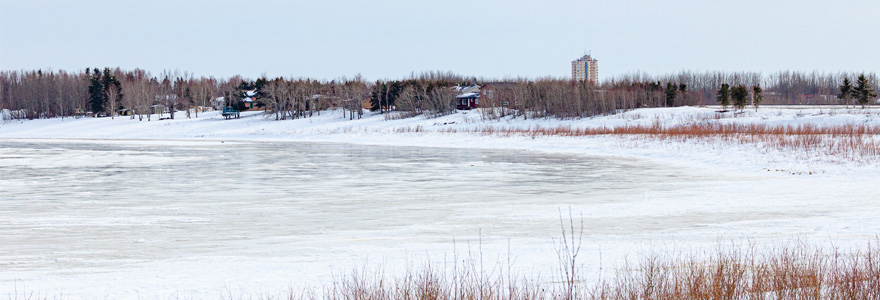News and Updates
Contact
Faculty of Social Science
Social Science Centre
Room 9438
Western University
T. 519-661-2053
F. 519-661-3868
E. social-science@uwo.ca
Everyday life in Canada's resource-rich north
March 21, 2023
Mackenzie Place stands above the town of Hay River, Northwest Territories - photo by Jesse Colin Jackson
Story by Rob Rombouts
Mackenzie Place dominates the landscape of Hay River, Northwest Territories. The 17-storey tower was constructed in 1975, in preparation for the Mackenzie Valley Pipeline. While the pipeline was never completed, the tower stands as a reminder of the proposed project.

Lindsay Bell, Department of Anthropology
In her upcoming book, Under Pressure: Diamond Mining and Everyday Life in Northern Canada, Bell uses Mackenzie Place as the central focus as she examines the way resource extraction has impacted demographics, economics and culture in Hay River, and the Northwest Territories more broadly.
Elements of her book are also being combined with photography and video for an exhibit created by Jesse Colin Jackson, opening in Pari Nadimi Gallery in late March.
The book speaks “to the diversity of people making up this part of the North,” Bell said, which she describes as “a rotating cast of characters.” This includes people from across Canada, particularly the Atlantic provinces, from around the world, including 500 migrants from the Philippines alone, as well as Indigenous peoples, from Northwest Territories, and from other resource-rich areas, who moved into Hay River as they have the skills required by industry.
Impacts of extraction
“People don’t live in relation to one commodity,” Bell said. “They live in terms of the on-going focus on resource extraction and the architecture and systems built to support those extraction projects that carry-on.”
The Northwest Territories has a long history focused on resource extraction, including fur trading, gold, natural gas and oil, and diamonds. Hay River is located on the south shore of the Great Slave Lake, and at the mouth of the Hay River, making it an important logistical hub for resource extraction.
In the early 21st-cenutry, as the purchasing public became more concerned with the negative consequences of diamond mining and trading, with terms such as blood diamond in the public conscious, Canadian-mined diamonds were marketed as an ethical alternative. In 2007, Canada became the third largest producer of diamonds in the world, with most mining occurring in the Northwest Territories. Hay River saw the impact of that growth in diamond mining.
“In the 1960s and 70s, when there was Indigenous resistance to the construction of the MacKenzie Valley Pipeline, Northwest Territories was at the forefront of the Indigenous resistance movement,” said Bell, “and now it has become one of the leaders in resource extraction.”
While mining companies promoted job-training and resource sharing, particularly for Indigenous communities, Bell said these stated benefits have not come to pass. “The quality-of-life indicators have not experienced a radical shift. GDP doubled in a short time, but other indicators in personal lives have not,” she said.
Even though the community member have not seen the promised benefits, the international views on Canadian diamonds have not changed and the “Canadian-ness” is still used as a selling feature.
The diamond companies “are still the same global players,” said Bell. “The failure of industry gets turned back on individuals, and the feeling is that if people did not benefit from the extraction economy, it’s because they didn’t want to take part.”
Building public understanding
Bell said that for many people, northern Canada is considered to be a vulnerable place, with a traditional culture. Hay River, she said, may not seem representative of northern Canada.
Through her book, and the exhibit, Bell and Jackson want to focus on the “everyday-ness” of the North, and make people reconsider their assumptions.
The exhibit includes Bell’s fieldnotes, still images of Hay River, and a composite video, recorded from the top of Mackenzie Place, with a camera pointing in each of the four cardinal directions. As the video plays, viewers can witness a full year of life and activity in Hay River. Excerpts of Bell’s book acts a soundtrack for the display, read by four different people.
The script includes vignettes about people living in Mackenzie Place. “Without the context from the research, people wouldn’t necessarily be able to understand what you are seeing,” said Bell. “People who wouldn’t read an academic book will experience it in this way.”

Zsofia Agoston Villalba,
graduate student in Anthropology
Zsofia Agoston Villalba is an MA student in sociocultural anthropology. She assisted Bell in developing the script, and is one of the voices reading passages in the video.
“Artwork can help translate well to a non-academic audience, and this is an exercise to how you can achieve both,” said Agoston. As an undergraduate student, she double-majored in anthropology, and museum and curatorial studies. The exhibit was an excellent way to blend her anthropological work and museum studies.
“It shows the potential of art and anthropology and how it can reflect different experiences,” she said. “It’s a very immersive experience that respects, but understands, the boundaries of anthropological work.”
With the support of a SSHRC knowledge mobilization grant, Bell plans to study how the gallery piece impacts how people see and understand life in the North.
When considering the costs and benefits of resource projects Bell said “you can’t use the same terms of what industry uses for resource extraction or how industry considers projects,” which is usually focused on a short term and within limited space.
“It’s important to zoom out,” she said, and use a more anthropological way to see the impact of industry, including speaking to more people and understanding that communities, especially Indigenous communities, are not homogenous.
Resource extraction has continued to expand in the Northwest Territories, and in 2022, Cheetah Resources, owner of Canada’s first rare earth mine sent its first shipment of rare earths from Hay River to Saskatchewan. As for Mackenzie Place, the building was abandoned in 2019, following a fire, and was sold to new owners in 2022.
The exhibit, Mackenzie Place, runs from March 23 to June 3. The gallery will also host a book launch for Under Pressure on Saturday, May 13th.

